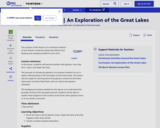
In this lesson, students will become familiar with glaciers, how they form, move, and shape the land.
- Subject:
- Earth and Space Science
- Science
- Material Type:
- Lesson Plan
- Provider:
- Great Lakes Now
- Date Added:
- 12/20/2021

In this lesson, students will become familiar with glaciers, how they form, move, and shape the land.

Students will learn about the nitrogen and phosphorus cycles and investigate how these nutrients are cycled through the ecosystem near Toledo, OH, eventually causing significant algal blooms that threaten the water supply along the western coastline of Lake Erie.

In this lesson, students will explore several contemporary issues facing the Great Lakes, including naturally occurring phenomena, such as invasive species, and issues that arise as a result of human activity, such as chemical pollutants.

Students will be introduced to the threat of coastal flooding that faces the Great Lakes and many other coastal areas in the world due to climate change.
![[Debate]: Which of the Five Great Lakes Is Best?](https://img.oercommons.org/160x134/microsite-infohio-prod/media/upload/materials/screenshots/materials-course-12773.png)
In this lesson, students will synthesize learning about the five Great Lakes and apply their knowledge to engage in a debate about which of the Great Lakes is the best lake.
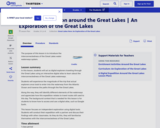
In this lesson, students will act as digital explorers traveling through the Great Lakes using an interactive digital atlas to learn about the interconnectedness of the Great Lakes waterways.

Students will understand the link between fish population dynamics and the fishing industry. There is a mutual relationship between the two, which students should realize by the end of the lesson, because humans and fish are part of a common food chain in the Great Lakes.
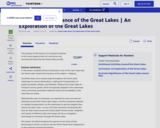
In this lesson, students will be introduced to one of the main ways that the Great Lakes impact the economy of the region—shipping.

Great Lakes Now: An Exploration of Threats to the Great Lakes is an introduction to the natural threats to and human impact upon, the Great Lakes. This collection of lessons — the second volume — aims to build on prior knowledge introduced to students in the first volume pertaining to basic scientific and geographic concepts about the Great Lakes but focusing how manmade and naturally occurring conditions threaten aspects of the world’s largest supply of surface freshwater. There are 11 lessons in this collection, each aligned to the Next Generation Science Standards and either Common Core standards, Earth Science or SEP standards. The lessons feature a number of interactive and hands-on activities for students to explore topics ranging from invasive species and algae to climate change and pollution. Beyond the specific look at some of the harm to the Great Lakes environment, this lesson collection gives special attention to potential solutions to the problems threatening the Great Lakes and explores some of the restorative measures being taken on some of the issues. Through the activities and lessons, students are introduced to ways that they can adjust their own behavior, or raise the awareness of those around them in their lives, to positively impact the Great Lakes and work to mitigate the effects of some of the threats. The 11 lessons from this collection can be taught individually or sequenced together as a larger unit on modern threats facing the Great Lakes. Embedded throughout the collection are links to videos produced by Detroit Public Television and Great Lakes Now, as well as a range of other resources from PBS that support citizen science and encourage exploration.
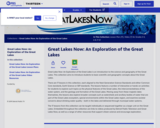
Great Lakes Now: An Exploration of the Great Lakes is an introduction to the science and study of the Great Lakes. This collection aims to introduce students to basic scientific and geographic concepts about the Great Lakes. There are 17 lessons in this collection, each aligned to the Next Generation Science Standards and either Common Core standards, Earth Science or SEP standards. The lessons feature a number of interactive or hands-on activities for students to explore such topics as the physical features of the Great Lakes, the interconnectedness of the water system, and the geology and formation of the Great Lakes. Moving away from these majestic lakes themselves, the lessons also explore broader concepts such as watersheds and ancillary bodies of water that are part of the Great Lakes ecosystem, special environments within the Great Lakes region, and examine societal concerns about drinking water quality – both in the lakes and delivered through municipal water systems. The 17 lessons from this collection can be taught individually or sequenced together as a larger unit on the Great Lakes. Embedded throughout the collection are links to videos produced by Detroit Public Television and Great Lakes Now, as well as a range of other resources that support citizen science and encourage exploration.

Students will become familiar with fatbergs, how they form, move, and affect the sewer systems of municipalities.

Students will model how the population of two freshwater fish species change over time and depend on one another.
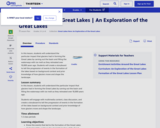
In this lesson, students will understand the particular impact that glaciers had in forming the Great Lakes by carving out the basin and filling the waterways with ice melt as they retreated over 10,000 years ago.

Students will learn about a remote Canadian research station where scientists are working to understand the effects of oil spill pollution on freshwater and simulate an oil spill cleanup effort in the lab.
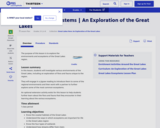
In this lesson, students will investigate various environments of the Great Lakes, including an exploration of flora and fauna unique to the region.
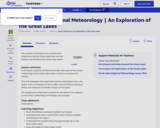
In this lesson, students will become familiar with some of the unique meteorology of the Great Lakes region in terms of weather and climate.
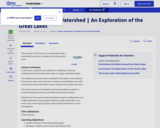
In this lesson, students will model how a watershed works to understand how the Great Lakes basin is a large watershed region.
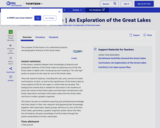
In this lesson, students deepen their knowledge of physical and geographic features of the Great Lakes by exploring one of the five Great Lakes in depth with a study group and creating a “for sale sign” poster to present to the class for one of the Great Lakes.
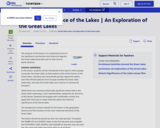
In this lesson, students will be introduced to the ways in which people encounter the Great Lakes as they explore some of the history of the Great Lakes, including how local people groups regard the waters, how New World explorers from Europe traveled the Great Lakes waterways, and how the Great Lakes are a source of commercial transport.
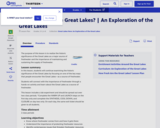
In this lesson, students will continue examining the historic significance of the Great Lakes by focusing on one of the key ways that people encounter the Great Lakes—as a source of freshwater.